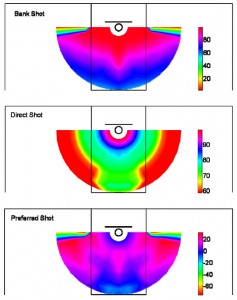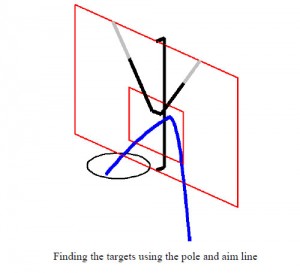Take It to the Bank
Your NCAA college basketball tournament bracket is most likely, like The Abstract’s, busted. But there’s still a reason – even though it’s baseball season – to watch the final three games of the tourney.
That reason is the bank shot. More specifically, whether that big game-winning or momentum-breaking shot – cue “One Shining Moment” – kissed the backboard or hit nothing but net.

NC State engineers simulated a million basketball shots from all over the court on a computer and then crunched the data. They found that, from certain areas of the court – at many angles inside 12 feet from the basket and on the “wings” between the three-point line and the free-throw lane – bank shots can be up to 20 percent more effective than swish shots. (See figure at right.)
They also found the optimal points on the backboard where the simulated baskets were aimed. First, you need to imagine a vertical line 3.327 inches behind the backboard that bisects the rectangular “square” on the backboard.
Then, you need to imagine the aim points certified by the computer simulations as the aim points on the backboard. These points make a “V” shape near the top of the “square.”
Then, wherever you are on the court, you find where the vertical line crosses your aim point and aim for that spot. That should increase your chance of making the shot. (See figure at left.)
(See figure at left.)
OK, so you can’t take a slide rule out on the court – unless you play for CalTech, where slide-rule use is not only legal but encouraged. But the NC State researchers say that knowing more about the aim points can help basketball players get a better idea of where to aim their bank shots.
And one more unrelated hint about watching the NCAA tournament: Anecdotal evidence suggests that the mute button is completely useless if Gus Johnson is the play-by-play announcer. His screams apparently overwhelm all of the television’s muting effects. Watch this space for an upcoming peer-reviewed paper on this amazing phenomenon.
- Categories:


